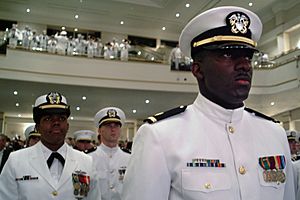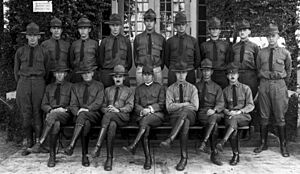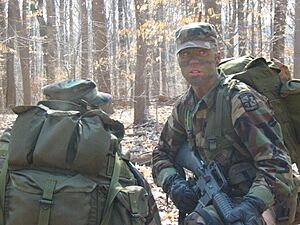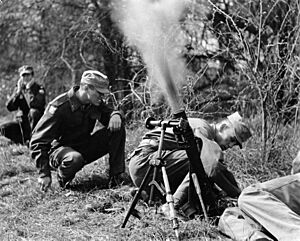Reserve Officers' Training Corps facts for kids
The Reserve Officers' Training Corps (ROTC) is a special program in colleges and universities across the United States. It helps train students to become officers in the U.S. Armed Forces after they graduate.
ROTC officers serve in many parts of the U.S. military. While the U.S. Marine Corps, U.S. Space Force, and U.S. Coast Guard don't have their own ROTC programs, students in Naval ROTC can choose to become Marine officers. Also, Air Force ROTC graduates can become Space Operations Officers in the Space Force.
In 2020, a large number of new officers came from ROTC. For example, 70% of new U.S. Army officers and 61% of new U.S. Navy officers were ROTC graduates.
Students in ROTC can get scholarships that help pay for college tuition, books, and other fees. In return, they agree to serve in the military after they finish their studies. ROTC students go to college like everyone else, but they also get military training through their ROTC unit. They practice regularly during the school year and have special training during the summer.
Army ROTC students are called cadets. Air Force ROTC students are also called cadets. Naval ROTC students are called midshipmen. They also have "Marine Option" students who will become Marine Corps officers. Some summer training for Army ROTC cadets includes Airborne (parachute jumping) and Air Assault (helicopter operations). Air Force ROTC cadets have Field Training, and Naval ROTC midshipmen go on summer cruises, which are like training trips on ships or at bases.
Contents
How ROTC Started
The idea for ROTC in the U.S. came from Alden Partridge, who founded Norwich University in 1819. He believed in "citizen soldiers." These were people trained for military roles if needed, but who could also live normal civilian lives during peacetime.
In 1862, the Morrill Act helped create many "land-grant colleges." These schools were required to teach military skills. Another important step was the "Plattsburg Idea" in 1915. Major General Leonard Wood started training camps to quickly turn civilians into officers.
In 1916, Congress officially created ROTC as part of the National Defense Act of 1916. The very first ROTC unit began at Harvard that same year.
By 1928, ROTC programs were in 225 colleges and universities. They were training about 6,000 new officers each year. In the 1930s, some high schools even had Junior ROTC programs.

For a long time, many universities required all male students to join ROTC. But in the 1960s, during the Vietnam War protests, this rule changed. ROTC became a choice, not a requirement. Some schools even removed ROTC from their campuses, though students could still join programs nearby.
Today, over 1,700 high schools have Junior Reserve Officers' Training Corps (JROTC) programs.
In recent years, some universities that had stopped ROTC programs, like Columbia, have brought them back. For example, the Harvard ROTC program returned in 2011.
Different Kinds of ROTC Programs
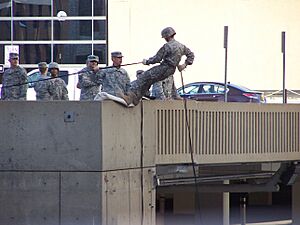
There are three main types of ROTC programs:
- Senior Military Colleges: These are special military schools where students earn college degrees. Many students in these schools are part of a "corps of cadets" and must take at least two years of ROTC training.
- Civilian Colleges: Most ROTC programs are at regular colleges and universities that are not military schools. Students here choose to join ROTC.
- Military Junior Colleges (MJC): These schools offer two-year degrees. Students can become second lieutenants in the Army Reserve or Army National Guard after two years. They then finish their four-year degree while serving. Only the Army has this "Early Commissioning Program."
A big difference is that at civilian colleges, joining ROTC is voluntary. But at senior and junior military colleges, it's usually required for students in the cadet program. Also, graduates from senior military colleges are often guaranteed active duty service if they want it.
U.S. Army ROTC
The Army Reserve Officer Training Corps (AROTC) is the largest ROTC program because the Army is the biggest part of the military. There are more than 20,000 Army ROTC cadets at 273 universities across the U.S. Most Army officers come from AROTC.
AROTC offers scholarships for students. High school seniors can get a four-year scholarship. College students can join later and earn a scholarship for their remaining years.
To get a scholarship, you usually need to be a U.S. citizen, have a high school diploma, be between 17 and 27 years old, have good grades, and meet Army fitness standards. You must also agree to become an officer and serve in the Army after graduating.
During the summer between their junior and senior years, Army ROTC cadets go to Advance Camp at Fort Knox, Kentucky. This is a big training event where cadets are tested on their leadership skills.
The Naval Reserve Officer Training Corps (NROTC) program started in 1926. The U.S. Marine Corps joined the program in 1932. NROTC is available at over 150 colleges nationwide.
U.S. Air Force ROTC
The first Air Force ROTC units began between 1920 and 1923 at several universities, including the University of California, Berkeley and Texas A&M University. After World War II, the Air Force created ROTC units at many more colleges.
ROTC Programs in Other Countries
Other countries that have close ties to the United States also have ROTC programs:
- Philippines: ROTC in the Philippines started in 1912. It's estimated that 75% of officers in the Armed Forces of the Philippines come from ROTC.
- South Korea: ROTC in South Korea began in 1961.
- Taiwan: ROTC in Taiwan started in the 1960s.
Other countries also train reserve officers. For example, Russia has had reserve officer training since the 1920s. Brazil has similar programs called CPOR and NPOR since 1928.
Student Army Training Corps (SATC)
During World War I, the U.S. created the Student Army Training Corps (SATC). This program encouraged young men to go to college and train for the military at the same time.
Joining the SATC was voluntary. In October 1918, 525 universities had SATC units with 200,000 students. Students in SATC were considered privates in the army, and some became sergeants.
When World War I ended in November 1918, the Army no longer needed so many soldiers. The SATC was closed in December 1918, and its members were honorably discharged.
Famous Members
Some well-known people who were part of the Student Army Training Corps include:
- William O. Douglas, who became a judge on the U.S. Supreme Court.
- Kenneth Keating, a U.S. Senator and ambassador.
- Claude Pepper, a U.S. Senator and U.S. Representative.
See also
- Early Commissioning Program
- Junior Reserve Officers' Training Corps (JROTC)
- United States Service academies


